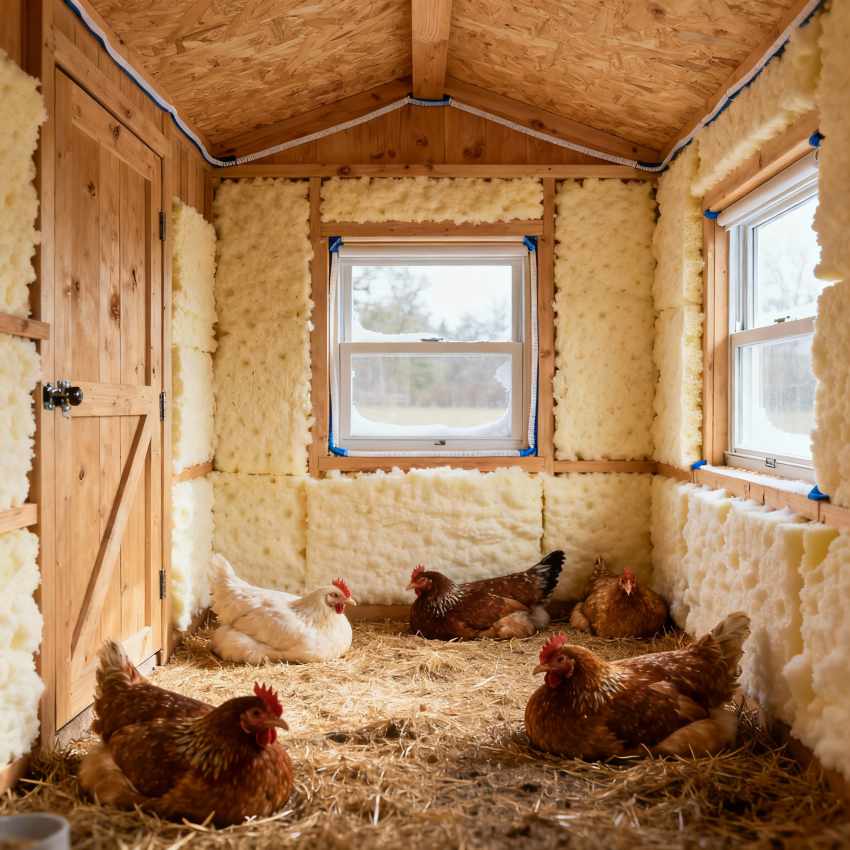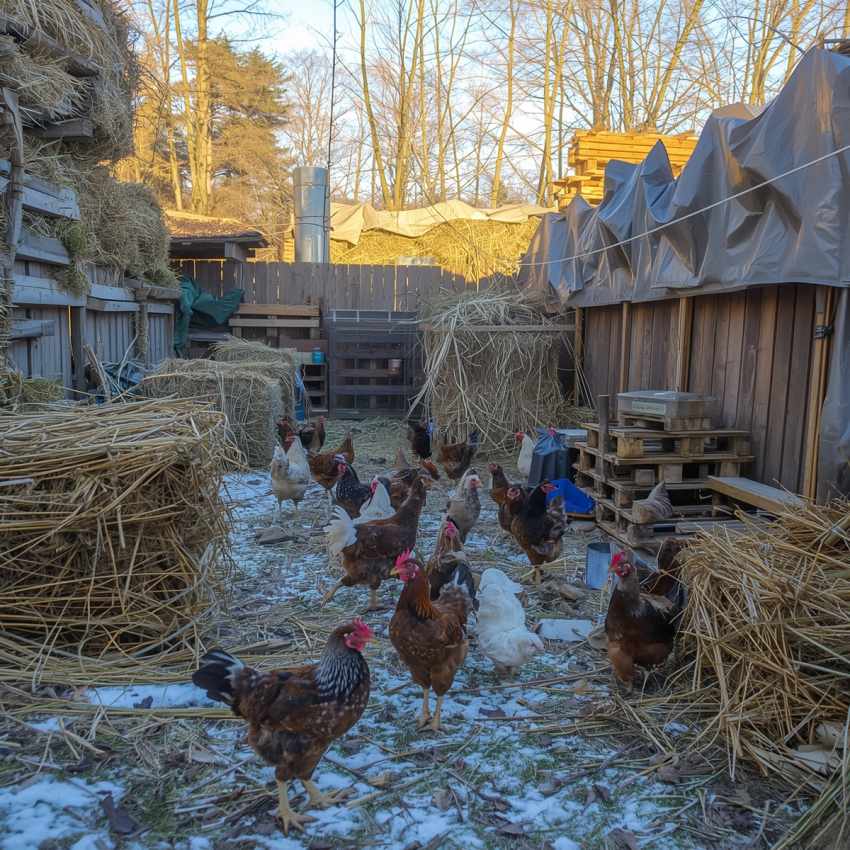Like you winterize plants in the garden, your flock too need extra care in winter. Prolonged exposure to cold can lead to frostbite, illness, and even death, especially for young or less cold-hardy breeds.
While most chicken farmers use heaters and heat bulbs to keep the chicken coop warm, experts don’t recommend it. Instead, you could use several sustainable options that naturally holds warmth.
If you rely just on heat lamps, then your chicken might experience difference in temperature between warmer in night and colder in day, which isn’t good.
Basically, chickens are actually quite resilient and can handle cold better than you might think, as long as they stay dry and protected from strong winds.
Their feathers act like built-in insulation, trapping body heat. But when moisture or drafts creep in, even the fluffiest hens can suffer.
So, before winter sets in, it’s worth taking the time to prepare their coop properly.
From insulation and ventilation to nutrition and bedding, each detail plays a role in keeping your flock warm and thriving all season long.
How to Keep Chickens Warm in Winter?
Choosing cold hardy chickens is the best way to save your flock from extreme low temperature.
Apart from these specific chickens, almost all hens are resilient creatures, but they still rely on you to keep them comfortable and safe during the coldest months. Without proper preparation, frostbite, respiratory problems, and stress can take a toll on their health and egg production.
1. Insulate the Coop Properly

Insulation is your first line of defense against winter’s chill. A well-insulated coop traps the chickens’ body heat and prevents cold air from seeping in. You can line the walls and ceiling with rigid foam boards, fiberglass insulation (covered to prevent pecking), or even recycled materials like cardboard or old blankets.
Focus especially on areas where heat loss is greatest—corners, the roof, and near the door. Adding weatherstripping or caulking around windows and gaps can make a surprising difference in temperature stability.
However, balance is key. Too much sealing can trap moisture and cause dampness, which leads to frostbite. The goal is a cozy, dry coop—not a stuffy one.
Also Read: How to Stop Chickens from Pooping in Nesting Boxes?
2. Use the Deep Litter Method
The deep litter method is a natural way to generate warmth inside the coop. Instead of cleaning out bedding frequently, allow it to accumulate and compost gradually. This slow decomposition releases a gentle, steady heat that helps keep the coop warmer.
Start with a base of clean pine shavings, straw, or hemp. Each week, add a fresh layer on top instead of removing the old one. As it builds up, microbes in the litter begin to break down organic matter, producing heat.
By the end of the season, you’ll have a rich compost pile that’s perfect for spring gardening. Just remember to stir it occasionally and keep it dry—moist litter can cause ammonia buildup.
Check this: 27 Herbs to Feed Chickens to Keep them Healthy
3. Eliminate Drafts but Maintain Ventilation
A draft-free coop is a warm coop. Walk around your structure and check for gaps, cracks, or unsealed joints where cold air might sneak in. These spots can cause temperature fluctuations that stress your flock.
Use weatherproof sealant, foam strips, or plywood panels to plug leaks. Concentrate on sealing openings at bird level, especially around the roosting area.
That said, ventilation is still essential to prevent condensation. Chickens breathe out moisture, and their droppings release ammonia. Place vents high up near the roofline to let humid air escape while keeping the interior draft-free at roost height.
4. Raise the Coop Off the Ground

A coop sitting directly on cold, damp ground loses warmth quickly. Elevating it by at least one foot keeps the floor dry, blocks cold drafts from below, and discourages rodents from nesting underneath.
You can use cinder blocks, bricks, or sturdy wooden posts to lift the structure. This small adjustment greatly improves air circulation and prevents water from pooling around the coop base.
Bonus: The raised design makes cleaning easier and extends the life of your coop by reducing moisture damage and rot.
5. Provide Plenty of Dry Bedding
Moisture is the enemy of warmth. Wet bedding soaks up body heat, leaving your chickens cold and uncomfortable. Always keep their floor thickly layered with dry, fluffy materials like straw, pine shavings, or shredded leaves.
Avoid sawdust or newspaper—these compact easily and don’t provide much insulation. Instead, aim for a bedding depth of at least 4 to 6 inches.
Regularly remove damp or soiled sections, especially near the waterer, and fluff up the bedding to keep air pockets that trap heat. The drier the coop stays, the warmer it feels inside.
6. Offer High-Energy Feed
When temperatures drop, chickens burn more calories to stay warm. Switching to a slightly higher-calorie winter diet helps them maintain body temperature and energy levels.
Supplement their regular layer feed with scratch grains, cracked corn, or black oil sunflower seeds. These foods digest slowly, generating internal warmth as your chickens roost at night.
Give a small handful per bird an hour before bedtime to “fuel” them through the coldest hours. Also, consider offering warm mash or oatmeal on especially frigid mornings—it’s comforting and hydrating.
Must Read: 70 Things Chickens Can Eat & 30 Food Items to Avoid
7. Keep Water from Freezing
Access to liquid water is vital, even when it’s below freezing. Dehydration can lead to poor digestion and reduced egg production.
If you don’t have a heated waterer, try using black rubber tubs that are easy to crack ice from. Place them in a sunny or sheltered spot to slow freezing.
Refill with warm water several times a day. You can also float a small ball (like a ping-pong ball) in the water to help keep it moving and delay freezing.
8. Use Windbreaks Outside

Chickens still love to forage and explore, even in winter, but cold winds can discourage them. Creating windbreaks helps them enjoy outdoor time safely.
Stack hay bales, wooden pallets, or use heavy-duty tarps around the run’s perimeter—especially on the north and west sides, where winter winds are harshest.
This not only blocks wind but also traps sunlight, forming a slightly warmer pocket of air where your flock can dust bathe, stretch, or peck comfortably.
9. Provide Proper Roosts
Roosting helps chickens conserve heat by huddling together and tucking their feet beneath their feathers. Make sure your roosting bars are 2–3 feet off the ground to avoid the cold floor.
Wooden perches are best since they don’t conduct cold like metal does. Choose smooth, rounded edges so their feet can wrap comfortably.
Encourage them to roost closely, but not overcrowded—each bird should have about 8–10 inches of space. Together, their combined body heat creates a cozy microclimate through the night.
10. Add Natural Insulation Around the Coop
Adding natural insulation is an inexpensive and eco-friendly way to boost warmth. You can stack straw bales, wood chips, or even bags of leaves along the exterior walls of your coop.
These materials create a thermal barrier, trapping heat inside and blocking icy winds. Straw, in particular, works beautifully—it’s breathable yet insulative.
Just remember to keep these materials dry. Wet straw or leaves can harbor mold and pests, defeating the purpose. Replace or fluff them up periodically to maintain effectiveness.
11. Encourage Roosting Together
Chickens naturally huddle for warmth, especially during cold spells. Allowing them to roost close together helps share body heat and keeps everyone comfortable.
If your flock is large, make sure your roosting bars are long enough so everyone has room. Overcrowding can lead to pecking, but gentle closeness is beneficial.
On extra-cold nights, you might notice them forming tight clusters—this is normal and an effective way for them to stay warm naturally.
12. Protect Combs and Wattles from Frostbite
Frostbite often affects combs and wattles—the fleshy parts on a chicken’s head—because they’re most exposed to the cold. Apply a thin layer of petroleum jelly, Vaseline, or coconut oil as a protective barrier before bedtime on especially cold nights.
Focus on roosters and large-combed breeds, as they’re more prone to frostbite. Keeping coop humidity low also significantly reduces frostbite risk.
If you notice pale or blackened areas on combs, act quickly—move the affected bird to a warmer space and consult a vet if needed.
Cold-Hardy Chicken Breeds
Some chicken breeds are naturally better equipped for the cold. If you live in a snowy or frosty climate, choosing hardy breeds makes winter care much easier. Here are some excellent choices:
- Wyandotte: Dense feathers and calm nature make them excellent winter birds.
- Orpington: Heavy-bodied and fluffy, they’re known for their cold tolerance.
- Plymouth Rock: Hardy, friendly, and reliable egg layers even in cold months.
- Australorp: A great dual-purpose breed that handles low temperatures gracefully.
- Rhode Island Red: Tough and adaptable, ideal for variable weather.
- Cochin: Feathery legs and gentle temperament suit them for cooler regions.
- Brahma: One of the best cold-weather breeds, thanks to their large size and thick plumage.
Also Read: How to Build a Chicken Coop for 20 Chickens?
How to heat a chicken coop without electricity?
You can keep your coop warm naturally by insulating the walls, using the deep litter method, blocking drafts, and stacking straw bales around the exterior for extra insulation. Chickens’ body heat and composting litter will help maintain a comfortable temperature.
How to keep your chickens warm in the winter?
Provide a well-insulated, draft-free coop with plenty of dry bedding and high-energy feed. Encourage roosting together and use natural barriers like straw or wood to trap warmth.
How to keep a chicken coop warm?
Seal gaps, add insulation, and use deep bedding to retain heat. Ensure proper ventilation to prevent moisture buildup while keeping the air inside cozy and dry.
Conclusion
Keeping your flock warm through winter doesn’t require electricity or constant worry—just a bit of smart planning and consistency. With a draft-free, insulated coop, dry bedding, and energy-boosting food, your chickens will stay warm and comfortable even in freezing temperatures.
Remember, chickens are tougher than they look. By mimicking their natural needs—shelter, dryness, and good nutrition—you can help them thrive year-round. Come spring, your healthy, happy hens will reward you with strong egg production and cheerful clucking once again.

Khaja Moinuddin, a computer science graduate, finds joy in gardening and homesteading. Join him on this blog as he shares his experiences in homesteading, gardening, and composting


